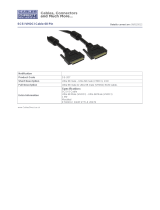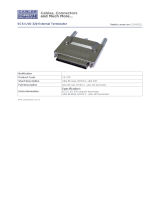
A REFERENCE GUIDE FOR OPTIMIZING DELL™ SCSI SOLUTIONS VER A02
PAGE 2 11/17/2005
TABLE OF CONTENTS
A REFERENCE GUIDE FOR OPTIMIZING DELL SCSI SOLUTIONS ............................................................... 3
1. INTRODUCTION ................................................................................................................................................... 3
2. STORAGE APPLICATIONS AND COMPONENTS .................................................................................................... 4
Identify customer usage model and needs ............................................................................................................. 4
Picking a solution based on the application profile.............................................................................................. 4
General RAID Configuration Guidelines .............................................................................................................................. 5
Application specific guidelines............................................................................................................................... 6
E-Mail Servers......................................................................................................................................................................... 6
Database Servers .................................................................................................................................................................... 7
Web Servers............................................................................................................................................................................. 8
Online Transaction Processing Servers................................................................................................................................. 9
File Servers............................................................................................................................................................................ 10
Streaming Media Servers...................................................................................................................................................... 12
Additional configuration factors.......................................................................................................................... 13
Hot Spares ............................................................................................................................................................................. 13
Clustering Considerations.................................................................................................................................................... 13
Considerations for Optimal RAID Performance................................................................................................................. 13
3. DELL’S PRODUCT OFFERING ............................................................................................................................ 14
PowerVault™ 220S & 221S Storage Enclosure................................................................................................. 14
PERC – PowerEdge™ RAID Controllers ..........................................................................................................14
SCSI Cabling.........................................................................................................................................................15
SCSI Hard Drive Support..................................................................................................................................... 16
3
rd
Party Hardware support................................................................................................................................. 16
Server Support ...................................................................................................................................................... 16
4. PV22XS ENCLOSURE OVERVIEW .................................................................................................................... 19
Joined Bus Topology ............................................................................................................................................19
Split Bus Topology................................................................................................................................................ 20
Cluster Topology .................................................................................................................................................. 21
PV22xS – Common Features and Capabilities................................................................................................... 22
SCSI ID Assignment.............................................................................................................................................................. 22
Multiple PV22xS Enclosures on a Single Host System ....................................................................................................... 23
Mixing EMM Speeds.............................................................................................................................................................23
Mixing HDD Capacities ....................................................................................................................................................... 24
Mixing HDD Spindle Speeds................................................................................................................................................ 24
SCSI Enclosure Services (SES) ............................................................................................................................................ 24
Warm and Hot Pluggable Features ..................................................................................................................................... 24
External SCSI Cables............................................................................................................................................................ 25
External SCSI Connector Types........................................................................................................................................... 25
PV22xS Configuration Topology and Application Attributes............................................................................................. 26
5. SCSI HOST BUS ADAPTERS / SCSI RAID....................................................................................................... 29
RAID: Hardware Vs Software ............................................................................................................................. 29
Considerations to Implement a RAID Solution................................................................................................... 29
Controller Family..................................................................................................................................................................30
Data Protection Strategy ...................................................................................................................................................... 32
High Availability Needs – Clustering................................................................................................................................... 33
Heterogeneous vs. Homogeneous environments................................................................................................................. 33
Interface Channel Options – Internal/External/Multi channel device configuration ........................................................ 34
Capacity Needs – Virtual Disk Size...................................................................................................................................... 35
Additional RAID information............................................................................................................................... 35
6. SUMMARY AND CONCLUSIONS ........................................................................................................................ 39
7. APPENDIX – A: REFERENCES............................................................................................................................ 41
8. APPENDIX – B: GLOSSARY ............................................................................................................................... 42
9. APPENDIX – C: ABOUT THE DELL SCSI STORAGE SOLUTION TEAM ............................................................. 43
Authors .................................................................................................................................................................. 43
10. APPENDIX – D: REVISION HISTORY............................................................................................................. 44
























